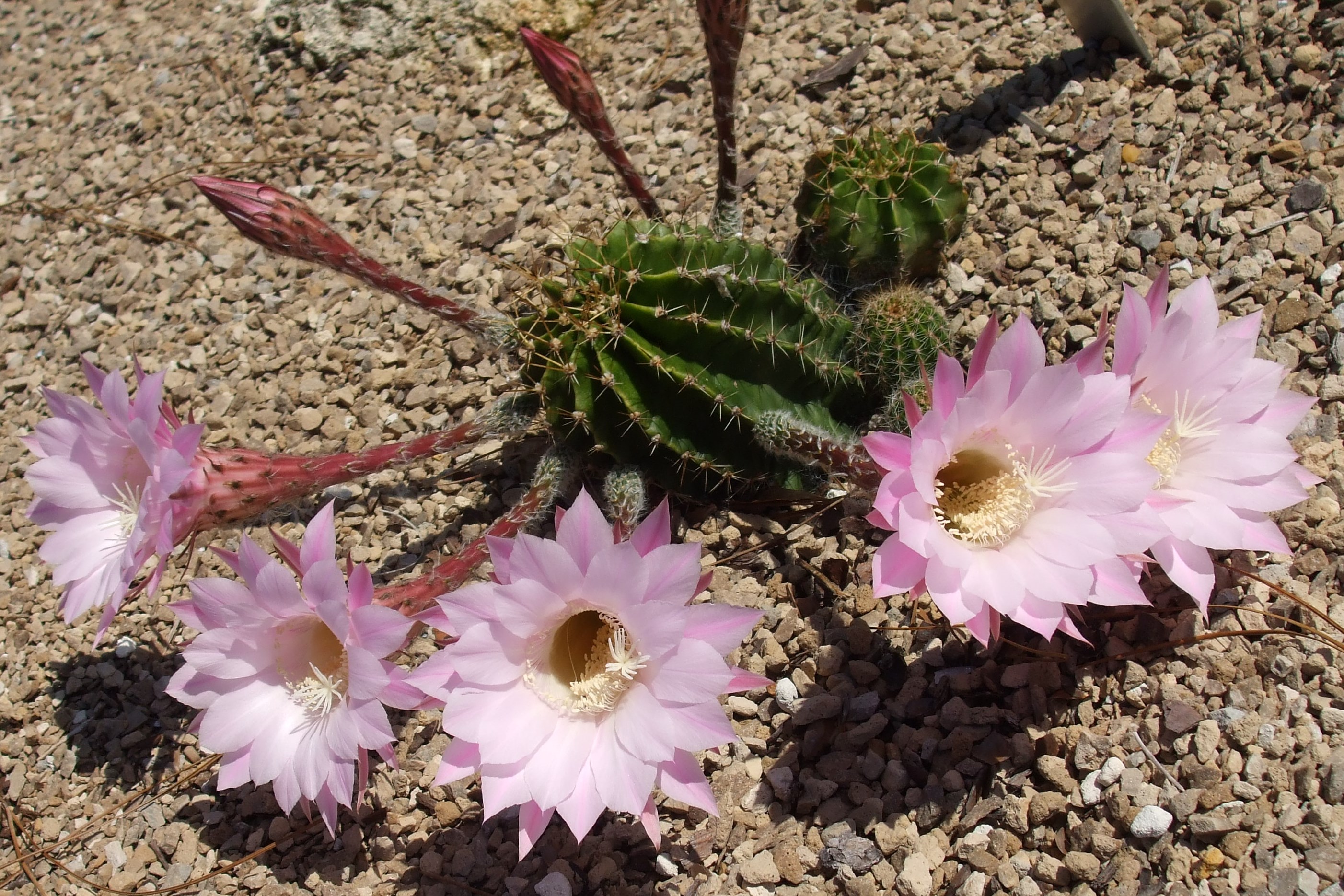
by Gary Knox | May 26, 2015
Summer is here, along with its heat, humidity, drought and stress! One easy way to garden during summer is to use succulents and other drought adapted plants.
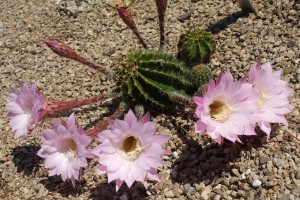
The sea urchin cactus (Echinopsis spp.) produces large, stunning flowers.
Succulents are heat-adapted, water-efficient plants often associated with deserts and dunes. Usually succulents have thick leaves or stems that store water. A cactus is a familiar type of succulent, as are agave, aloe, yucca as well as bromeliads like dyckia. Other dry-adapted plants can retreat into bulbs, rhizomes or other thick plant parts to go dormant until rains resume. A few other strategies used by plants to save water include: waxy or hairy coverings to reduce water loss; extensive root systems to absorb water; and silver- or blue-colored leaves and stems to reflect light and reduce heat.
Succulents’ tough qualities make them well-adapted to the harsh conditions of urban living amid concrete, brick, asphalt and other “hardscapes”. This adaptability translates into low maintenance since they need little or no irrigation, fertilization, pruning or spraying. Do you like container gardens? Succulents are almost the perfect container plant, because they hardly ever need watering!
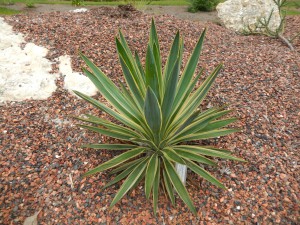
The American century plant (Agave americana) is a large growing succulent with silver-grey leaves.
Above and beyond their toughness, succulents capture our imaginations because they are often dramatic, dangerous and slightly unpredictable. Drama stems from the architectural forms of many thick-leaved plants like agave. Danger arises from the thorns and spines of plants like cactus. Unpredictability results from bulbs and perennials that can quickly explode into flower, and then disappear just as suddenly. Often succulents have outrageous flowers with wild, bold colors and strange shapes!
While many succulents are native to deserts, others are Florida natives where they can be found in coastal dunes or in areas with sandy soils that have little water-holding capacity. For example, many native yuccas are excellent succulents for use in dry gardens or in containers.
For best growth and appearance, most succulents require well-drained soil and full sun (at least 6 hours of direct sunlight per day). Succulents are ideal plants for garden beds near roads, sidewalks, driveways and south-facing walls because they tolerate limited soil moisture, higher soil pH and reflected heat and light usually associated with these areas. On the other hand, try to avoid planting succulents in shady areas, wet areas, low areas that collect water and areas with heavy soils.
Summer gardening is easy with succulents!
For more information:
Agave and Yucca: Tough Plants for Tough Times
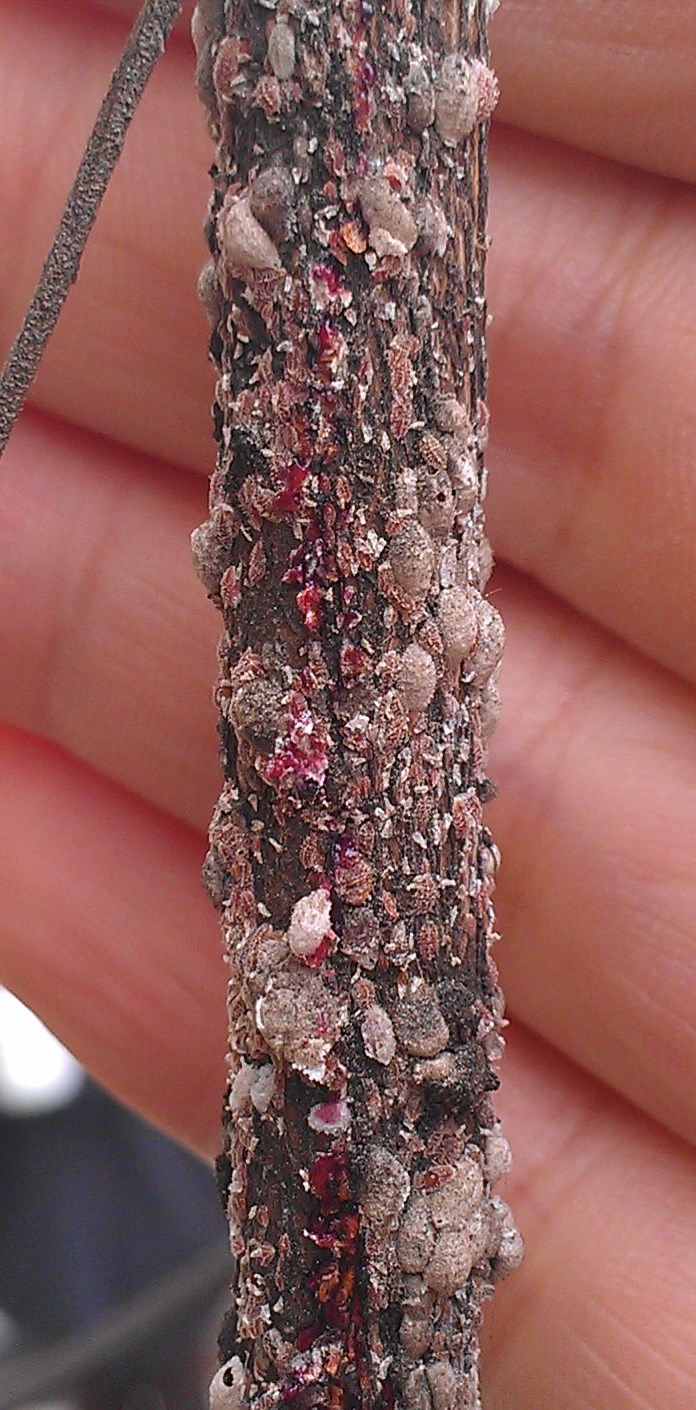
by Gary Knox | Mar 31, 2015
![Figure 1 Note the black sooty mold coating the layers of white and grey scale, believed to be crapemyrtle bark scale, Eriococcus lagerstroemiae. [Photo by Gary Knox]](https://nwdistrict.ifas.ufl.edu/hort/files/2015/03/crapemyrtlescalebark1.jpg)
Figure 1 Note the black sooty mold coating the layers of white and grey scale, believed to be crapemyrtle bark scale, Eriococcus lagerstroemiae. [Photo by Gary Knox]
Symptoms and Appearance
An early symptom of crapemyrtle bark scale is black sooty mold covering extensive areas of leaves and stems as a result of honeydew exuded by the scale (Fig. 1). Individual scale insects are white to gray in color and ooze pink when crushed (Fig. 2). Large populations build up in branch crotches and extend up branches, appearing crusty white to gray. This scale usually is not present on new growth, leaves or slender stems unless infestations are heavy.
For more information and additional photos
Resources, up-to-date information and additional photos about crapemyrtle bark scale may be found at http://www.eddmaps.org/cmbs/. This website will be the major portal for information about this pest.
![Figure 2. This white to grey colored scale oozes pink when crushed. [Photo by Gary Knox]](https://nwdistrict.ifas.ufl.edu/hort/files/2015/03/crapemyrtlescale2.jpg)
Figure 2. This white to grey colored scale oozes pink when crushed. [Photo by Gary Knox]
Research
Research on crapemyrtle bark scale is ongoing. Scientists from the University of Florida, LSU, University of Arkansas and Texas A&M are collaborating to develop Best Management Practices to manage crapemyrtle bark scale in the nursery and landscape. Initial research is examining the biology of the host-insect interaction to better understand its life cycle and stages when it may be most susceptible for control. Additional research will evaluate pesticides and other IPM strategies for managing this pest.
The expanding distribution of this scale and my personal observations of crapemyrtle bark scale throughout China suggest this scale could have a widespread and severe impact on crapemyrtles in landscapes. Please be on the lookout for crapemyrtle bark scale, and report sightings to your local county extension agent and Florida Department of Agriculture and Consumer Services Division of Plant Industry.
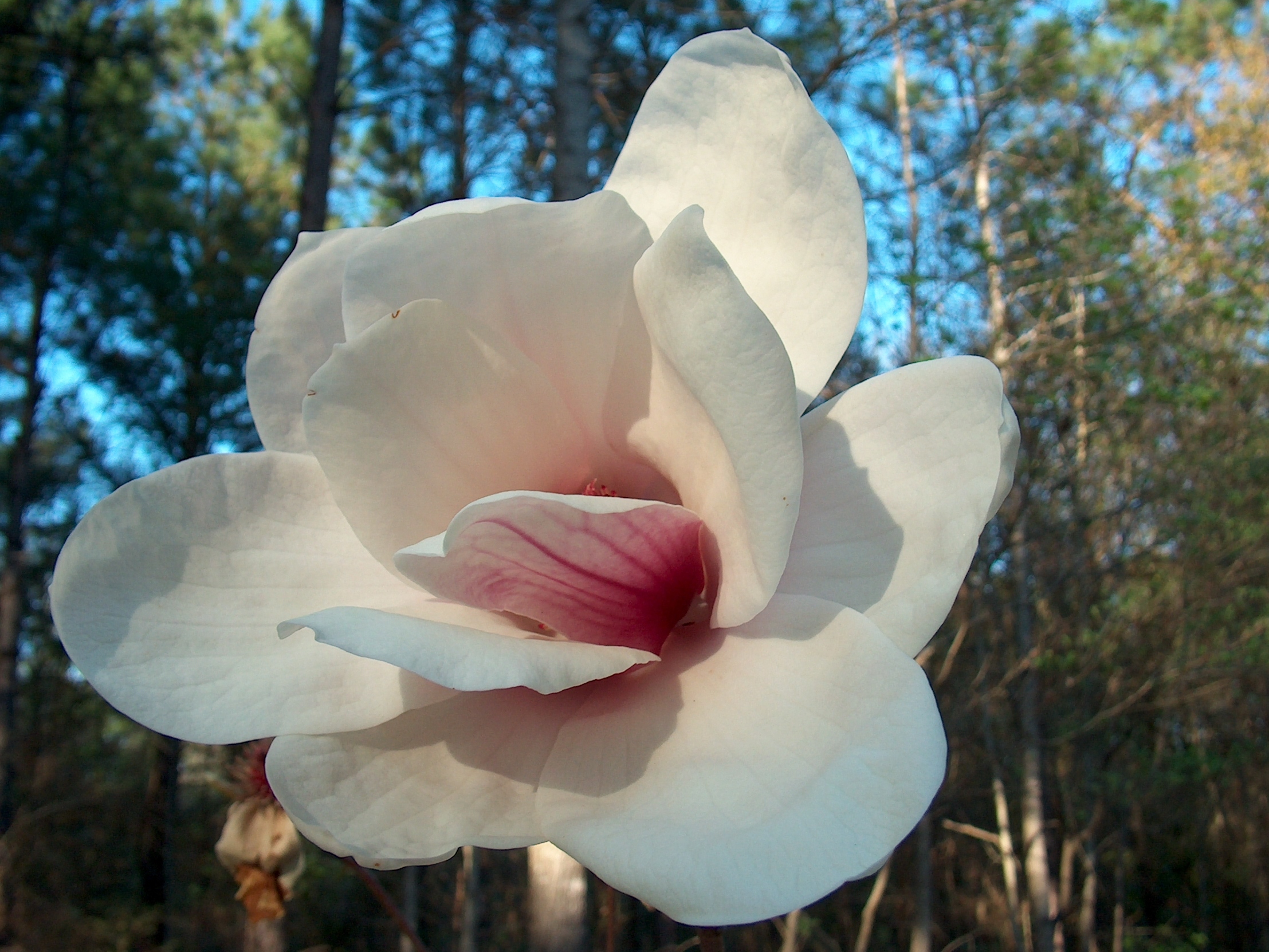
by Gary Knox | Feb 24, 2015
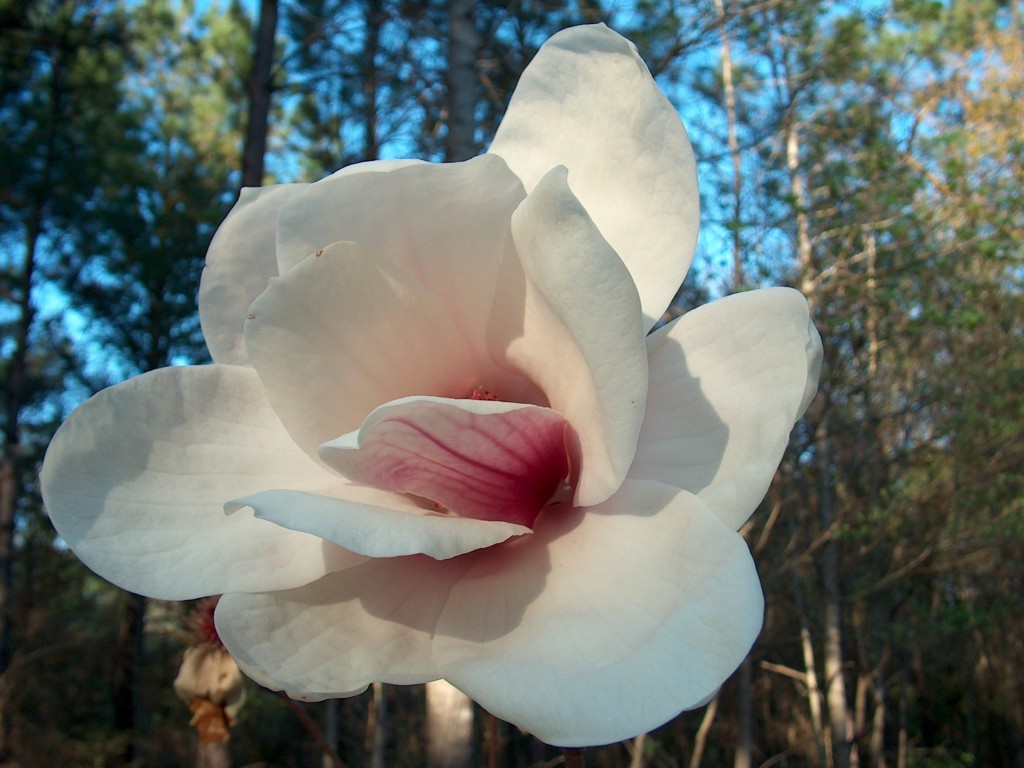
‘Jon Jon’ magnolia
This winter’s recurring freezes and frosts have played havoc with early flowering plants like magnolia. While buds are freeze-resistant, open magnolia flowers can quickly turn brown after exposure to temperatures about 30°F or lower. One way to avoid freeze-damaged flowers is to choose later blooming cultivars. These selections have flowers that open in north Florida during late February or later.
The Magnolia Garden at the University of Florida/IFAS North Florida Research and Education Center (NFREC) in Quincy has more than 150 types of magnolias planted. Based on over 10 years of data, five of the latest blooming magnolias are Daybreak, Jane, Betty, Jon Jon and Ann. These cultivars have peak bloom dates ranging from late February (Ann) to mid-March (Daybreak). Thus, they bloom after most flower-damaging freezes.
Daybreak has beautiful, large shell-pink flowers on a small tree. Jon Jon has huge white flowers with a streak of red-purple at the base. These fragrant flowers open goblet-shaped the first day, and then open wider to a cup-and-saucer shape on subsequent days. At NFREC, Daybreak and Jon Jon have about 6 weeks of flowers and grow as single-stem or multi-stem trees up to about 30 feet tall.
Jane, Betty and Ann are sister cultivars developed at the National Arboretum. As you would expect with sisters, they look-alike, and have a shrubby or multi-stemmed tree habit, generally growing about 15 feet tall and wide (much shorter and wider than Daybreak and Jon Jon). All three have upright, cup-shaped flowers in various shades of pink and red-purple. Betty has medium red-purple flowers that are the largest of the three, over 4 inches. Jane has 3- to 4-inch flowers that are medium pink outside and white or pale pink inside. Ann has the smallest flowers (3 inches) but they are also the darkest red-purple. As an added bonus, Ann boasts the ability to produce sporadic flowers all summer long! This results in Ann having an average of 13 weeks of flowers, as compared to Jane’s 10 weeks and Betty’s 8 weeks.
These five cultivars are generally available at garden centers during spring. Ann and Jane can be found at many “Big Box” stores. All five can be purchased at “good” independent garden centers and, as a last resort, from mail-order/Internet nurseries.
For more information about these and other magnolias, see Florida Extension publication, ‘Jon Jon’ Magnolia: A Late-Flowering Deciduous Magnolia for Northern Florida, and other magnolia publications here. Also, Magnolia Society International is a great resource with a very informative website. (Note the slide show below of Jon Jon, Ann, Betty, Daybreak and Jane.)
[portfolio_slideshow id=4059]

by Gary Knox | Feb 3, 2015

Figure 1. Topping is the drastic removal of large-diameter wood (typically several years old) with the end result of shortening all stems and branches. Topping is not recommended for crapemyrtle.
As the holidays fade and the New Year begins, we often see crapemyrtles being “mutilated” from improper pruning: main stems that are several years old are cut back, often leaving branch stubs 2 – 5 inches or more in diameter. This form of crapemyrtle mistreatment goes by various names, including topping, heading, stubbing, rounding, dehorning and (my favorite) “crape murder”.
Whatever you call it, topping a crapemyrtle is almost always unnecessary. Over the years, many people viewed this type of improper pruning and unthinkingly perpetuated the practice in their own yards, not realizing the unfortunate consequences.
Research at the University of Florida found that topping crapemyrtle delays flowering up to one month. For example, unpruned trees may begin flowering in June whereas topped trees begin flowering in July. This research also found topping reduced the number of flowers and shortened the flowering season. Finally, topping stimulated more summer sprouting from roots and stems. Sprouting results in greater maintenance since sprouts are usually removed to maintain an attractive plant appearance.
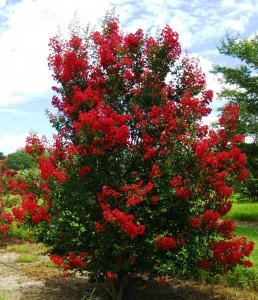
Figure 2. With proper cultivar selection and placement in the landscape, crapemyrtle develops into a beautifully shaped tree that rarely needs pruning. This crapemyrtle is Red Rocket®.
If a crapemyrtle is located where it requires routine pruning to fit into its surroundings (for example, under the eave of a roof), it should be replaced with a smaller growing crapemyrtle. A dwarf crapemyrtle (maturing at a height of 5 feet) would fit this location well. Medium crapemyrtle cultivars (growing up to about 15 feet in height) and tall or tree-size crapemyrtle cultivars (often growing 20 – 30 feet tall in 10 years) are best reserved for open areas.
Crapemyrtle thrives under full sun conditions in areas with ample room for the cultivar size and away from walkways and roads. Proper selection of crapemyrtle cultivar and proper placement in the landscape can result in a low maintenance crapemyrtle without the need for significant pruning.
For more information, please see Crapemyrtle Pruning.
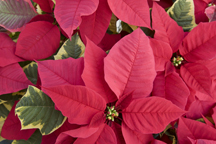
by Gary Knox | Dec 23, 2014
Poinsettias are one of the most popular plants during the Holiday Season. Poinsettias grow as shrubs in their native southern Mexico but have been bred to become compact, bushy plants perfect as container ornamentals. The showy “flowers” of poinsettias are actually modified leaves called bracts. Usually red in color, modern poinsettia breeding created showy bracts ranging in color from red to pink to white to orange, with lots of variegations and different leaf coloration patterns and sizes. The true flowers on poinsettias are the small green and yellow parts located in the center of each group of bracts.

Photo credit: Tyler Jones UF/IFAS.
Here are some do’s and don’ts to ensure that your poinsettias stay beautiful through the holidays and beyond:
- Do choose plants with true flowers that are greenish. Plants with unopened or newly opened flowers will last longer than those already sporting true flowers dusted with yellow pollen.
- Do choose plants that are bushy and leafy. Plants that have lost their lower leaves usually indicate the plant was mishandled and may decline quickly.
- Do place poinsettias in an area with bright light but not direct sunlight.
- Do keep poinsettias away from children and pets. Poinsettias are not poisonous but still might cause skin irritation and upset stomachs. People allergic to latex should be aware poinsettia sap contains latex-like materials.
- Don’t overwater poinsettias. Only water poinsettias when the top of the soil is dry, and let excess water drain away. Remove the poinsettia from the decorative foil wrapping to allow water to drain out.
- Don’t expose poinsettias to temperature extremes or drafty areas. Poinsettias like the same temperatures as people, so keep them away from cold (temperatures below 50) or heat (temperatures above 80).
After the holidays are over, you can plant poinsettias outdoors. For more information see:
Enjoy Your Poinsettias After the Holidays
In the meantime, enjoy your beautiful poinsettias and Happy Holidays!





![Figure 1 Note the black sooty mold coating the layers of white and grey scale, believed to be crapemyrtle bark scale, Eriococcus lagerstroemiae. [Photo by Gary Knox]](https://nwdistrict.ifas.ufl.edu/hort/files/2015/03/crapemyrtlescalebark1.jpg)





